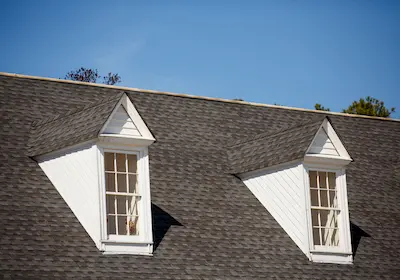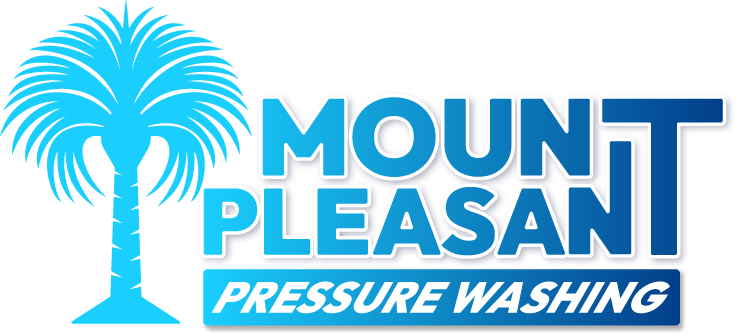
First identifying a dirty roof versus a clean roof is how you can determine when your roof needs maintenance. The organism that feeds off your roof shingles is called Gloeocapsa magma, which is a type of bacteria that feeds off of the limestone mineral in your roof shingles. They are often seen as “black streaks” on roofs that are gradually becoming dirty. Below is a picture of what Gloeocapsa magma looks like on a light grey roof before undergoing a roof cleaning.

The pictures in this roof cleaning were shortly after treating the roof with one of the chemicals we recommend using for washing roof shingles. The white streaks, which are now dead bacteria, will soon disappear over the course of a few weeks as rainfall rinses the dirty spots off the shingles.
For all of the following chemicals, we recommend applying the cleaning solution using a garden sprayer, wearing gloves and a respirator. Water all your plants before during and after chemical application and put a bag over your gutter downspouts to collect cleaning solution running down the drain. Dump any of the runoff collected in your bags onto your concrete driveway and let it biodegrade naturally.
Called SH for short, household bleach is the most widely used roof cleaning chemical, as it is the choice cleaning agent of nearly every pressure washing company in North America. Bought in large 55 gallon drums, millions of gallons of commercial grade sodium hypochlorite are used to clean building exteriors every year. For homeowners, we recommend stocking up on household bleach shortly before cleaning your roof in approximately a 20-25 gallon allotment. Pour a gallon of bleach directly in a pump sprayer and add 2 ounces of laundry detergent to help it stick to the roof shingles. Apply a light coat to all areas of the roof and reapply in about 30 minutes of there are still black streaks. After applying the chemical, the black streaks should turn from black to brown or even white. If they do not turn at least brown, reapply another coat.
Sodium percarbonate is a safer and more environmentally friendly option for cleaning your roof shingles, although it is less effective overall. We recommend this chemical for anyone with sensitive plants directly below their roof line such as Japanese maple trees or rose bushes. Sodium percarbonate is less likely to damage these plants so long as they are rinsed well afterwards.
We recommend buying OxiClean and dissolving the powder as per instructed on the container in warm water. Add a couple ounces of laundry detergent per gallon of cleaning solution made and apply as mentioned before. It may take more applications than using bleach, but you are less likely to cause any collateral damage to your landscaping because of taking the more environmentally friendly option.
Hydrogen peroxide is like sodium percarbonate in that it is more environmentally friendly than bleach, but usually less effective and more expensive. We recommend searching for 15% or higher hydrogen peroxide solutions which can be found at garden supply centers or cleaning supplier stores.
Put directly in your pump sprayer, add your laundry detergent, and get to spraying. Hydrogen peroxide should need a couple applications just like oxygen bleach.
Trisodium phosphate and sodium hydroxide are a type of chemical called degreasers, which can clean up food grease and they have paint stripping abilities as well. Adding a small amount of degreaser to your roof cleaning mix can be a great way to thicken the solution so it sticks better, as well as help cut through thick layers of dirt, algae, and moss. We recommend buying both at a chemical supply store or big box store. Here is how to mix both:
Make sure when adding degreaser that you rinse it from any other house surfaces the solution touches because degreasers have mild paint stripping abilities.
The frequency at which you need to clean your roof depends on several factors including the climate you live in, how much sun exposure your roof gets, and the color of your roof shingles. In moisture-heavy climates you may need to clean your roof every 2-5 years. In drier climates you can usually stretch this number to much longer. If you have a lot of tree coverage over your roof or accumulate a lot of debris, you will likely be closer to the 2-3 year range.
If your roof shingles are a dark grey color, you will not notice they are as dirty as quickly as someone that has a grey or tan colored roof. From a curb appeal perspective, darker colored roofs hide their dirtiness better and you can get by with minor staining for longer. This does not mean you should ignore a roof being decayed by limestone-eating algae, however.
If your roof is too steep to walk safely or you do not feel comfortable on your roof at all, or if you simply want to save an entire weekend of cleaning, call a professional that specializes in soft wash roof cleaning such as our team at Mount Pleasant Pressure Washing. With top-of-the-line roof cleaning machines and years of experience, we guarantee a spectacular-looking roof free of black streaks with no damage to plant life. Our professionally trained team and exceptional customer service is ready to service your roof and save you thousands of dollars of premature roofing damage.
